At about the midway point of the 2021/22 season, a tactical analysis piece was published on Total Football Analysis focusing on Lyon’s defensive difficulties during the early days of former Ajax, Borussia Dortmund and Bayer Leverkusen (just to name a few) head coach Peter Bosz’s tenure in charge at Groupama Stadium. We spent a large chunk of that analysis dissecting issues with Lyon’s centre-backs, in particular, and their tendency to struggle in aggressive defending/1v1 defending situations.
Lyon’s main central defensive partnership in the first half of the season was Jason Denayer and Jérôme Boateng, with Denayer lining up on the left and Boateng lining up on the right. However, in the second half of the campaign, Lyon moved to address their problems at central defence and the aforementioned pairing being their go-to ceased to be the case, with 19-year-old left-footed, left centre-back Castello Lukeba (184cm/6’0”, 73kg/160lbs) becoming a staple of the defence, featuring alongside one of Boateng or Denayer, along with natural midfielder Thiago Mendes and Damian Da Silva at times. In our piece looking at Lyon earlier this term, we mentioned that Lukeba, in his limited minutes, appeared to have the potential to be a better fit for Bosz’s system than Denayer and Boateng. When given more game time in the second half of 2021/22, the young Frenchman took the opportunity to prove this point, delivering such good performances that he ended up being nominated for Ligue 1’s Young Player of the Year award, with his Transfermarkt valuation increasing from just €400k at the beginning of the season to €20m.
Now, Transfermarkt valuations are hardly the be-all-and-end-all for evaluating players’ performances but it does go to show how the Lyon teenager’s stock skyrocketed during the most recent campaign thanks to his performances in Lyon’s system, partly through a coming of age on his own behalf but also with a large part of the credit due to Bosz and his system, which Lukeba is clearly a great fit for (thankfully, given how the Dutch coach’s original central defensive duo are absolutely not a good fit).
In this tactical analysis piece and scout report, we aim to highlight how Lukeba became a crucial part of Les Gones’ backline in his debut season for the first team, looking both at the player’s natural individual qualities as well as those qualities that made him fit like a glove in Bosz’s system, with the Dutchman’s tactics undoubtedly accentuating certain aspects of Lukeba’s game. This analysis aims to show why we back Lukeba to form a base for Lyon to build around at the back next season and beyond. Additionally, we will put the spotlight on some of the young centre-back’s areas of improvement, as like any teenager, Lukeba is certainly not the finished article, despite how highly we rate him and his contributions for Les Gones this term. All stats and data used in this scout report come from Wyscout unless otherwise stated.
Defensive qualities
At 184cm, 73kg, Lukeba is a decent size but far from imposing — there are many more physically-imposing centre-backs in Ligue 1 than the teenaged Lyon man. However, what he lacks in physicality, Lukeba makes up for in defensive technique, composure, reading of the game and something of an all-around air of class in defensive situations. Notably, Lukeba is more comfortable defending proactively and aggressively than any of his fellow Lyon centre-backs. This has seen him complete the most successful defensive actions of any Lyon player in Ligue 1 this season (9.84 per 90 — just above average for all of Ligue 1). His comfort with defending proactively and aggressively made him a great fit for Bosz’s side, who were crying out for this kind of player in the first half of the campaign before Lukeba had fully broken into the squad.
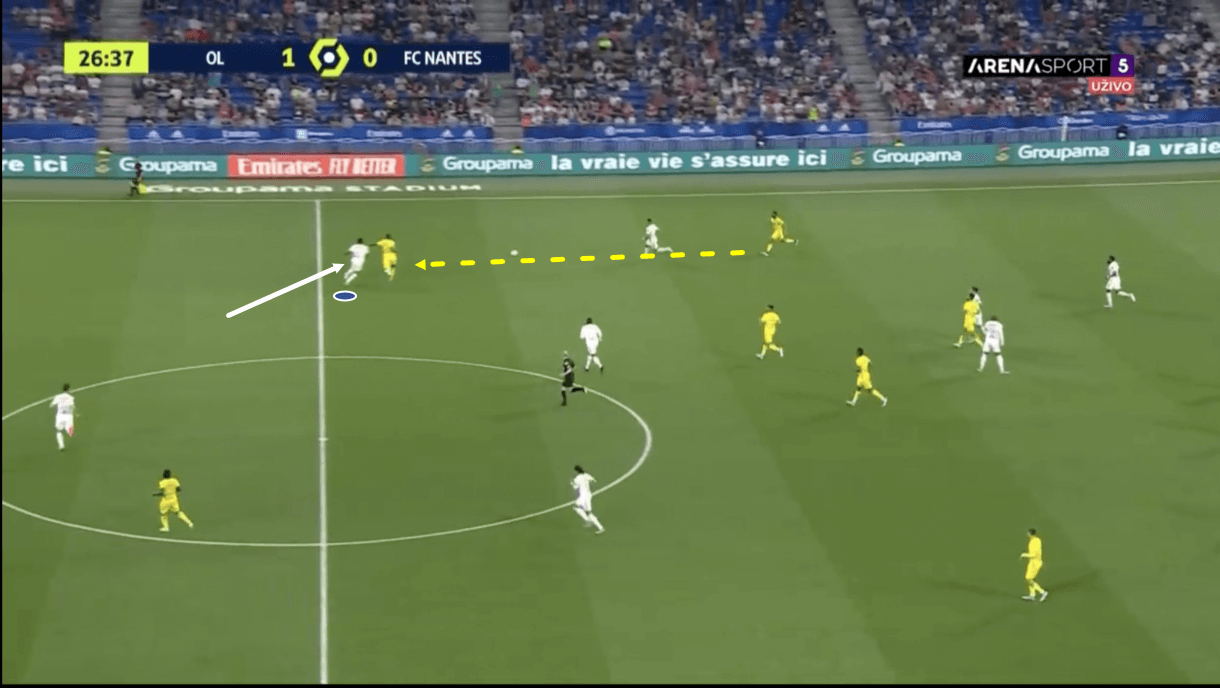
Figures 1-3 show an example of Lukeba’s aggressive defending, which came in useful for Lyon both in settled defensive phases and in transition to defence. Figure 1 shows an example of the latter, with the opposition having just driven from inside their third, through Lyon’s midfield and towards the halfway line with a powerful progressive pass sent into an attacking player’s running path. As the attacker runs onto this ball, he’s followed closely by Lukeba, who’s happy to step out of the backline at this point and follow the player leaving his zone into a more aggressive position where there’s plenty of space.
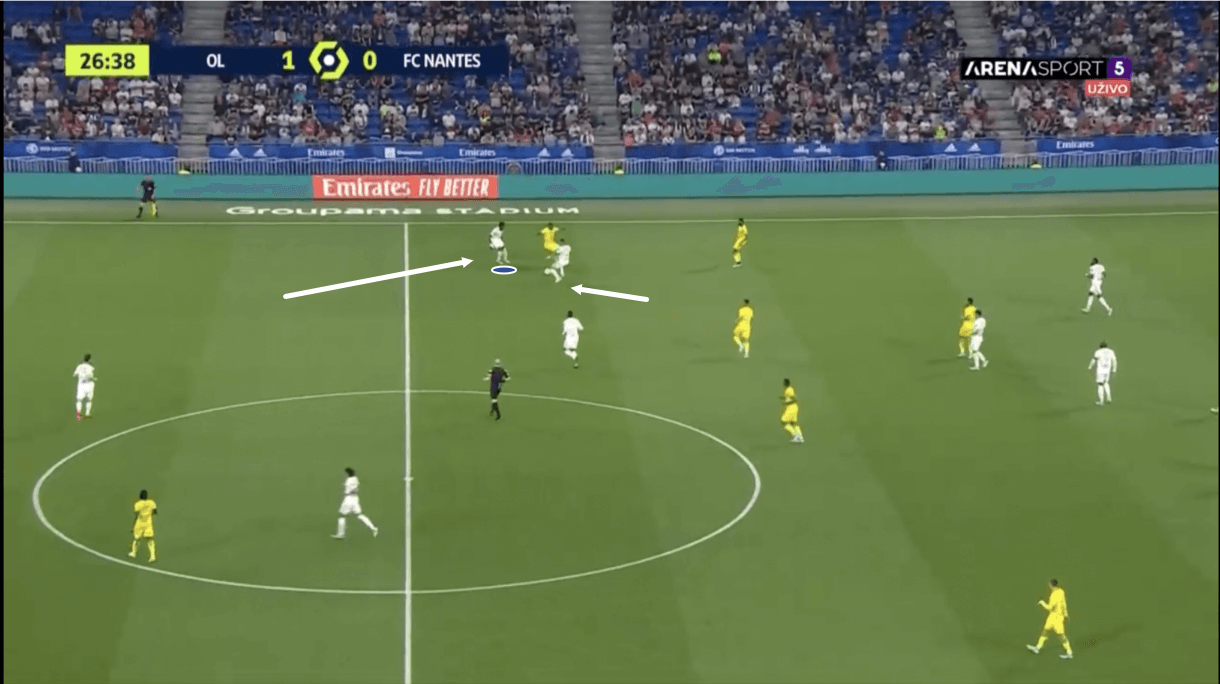
Lukeba needs to remain calm, composed and positionally aware in this situation, which he does. As we see from figure 2, the 19-year-old’s main focus at this point was to stand the attacker up, give him no chance to turn and either run at the backline or link up with a teammate to play around Lyon’s defence, and buy his midfielders time to recover and assist him in winning the ball back by doubling up on the opposition ball carrier. Lukeba successfully achieved this by remaining tight to the attacker, getting physical to control the player’s movement and utilising the correct side-on body positioning to ensure the attacker found it more difficult to back into Lukeba and the centre-back could continue forcing the attacker away from a more valuable position all the while buying time for his teammate to get back and help out.
There are plenty of examples of the 19-year-old performing this valuable role for his team in 2021/22, and he successfully demonstrated the necessary composure, levels of physicality and technical ability to perform this role at a pretty high level.
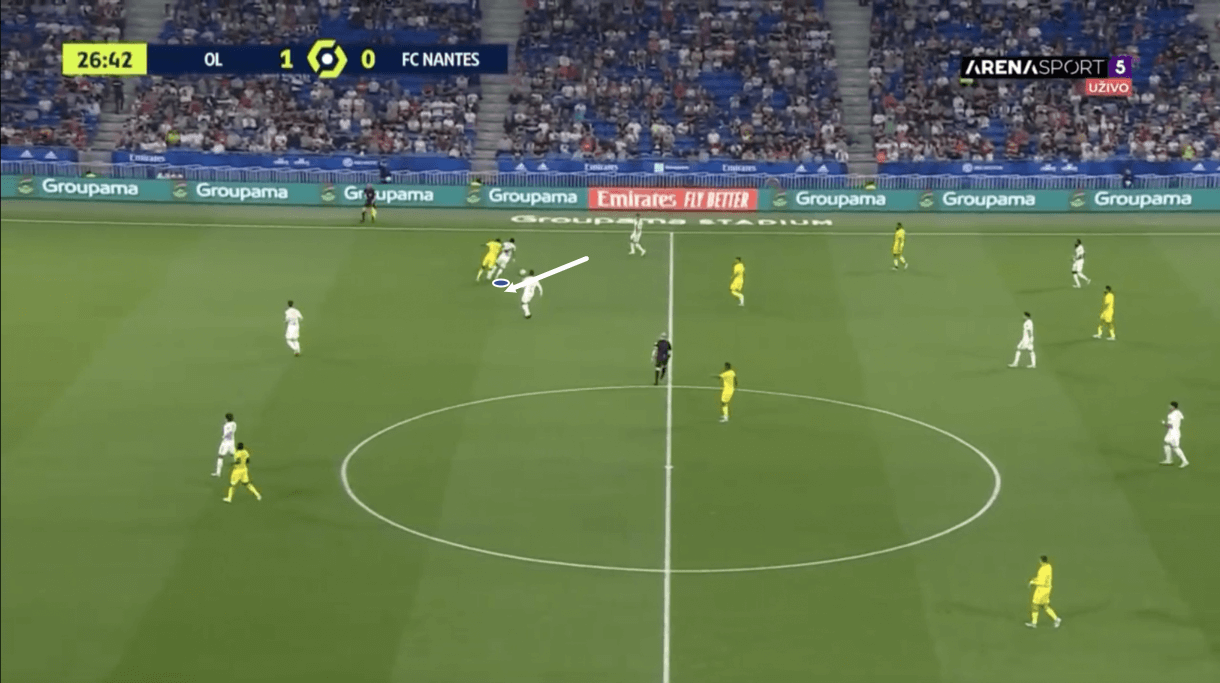
On this occasion, as we move on into figure 3, we see that Lukeba’s midfield teammate actually failed to regain possession, with the attacker managing to squeeze forward through the gap between Lukeba and his teammate. However, Lukeba to the rescue; the centre-back remained alert and showed excellent recovery pace as well as, again, calmness and composure to react to the situation positively, getting back quickly to put his body between the attacker and the ball, ensuring the attack went no further than just inside Les Gones’ half and the ball returned to Lyon’s possession.
In general, Lukeba does possess solid recovery pace along with the aforementioned attributes, combining together to make him a great option for Lyon when in need of someone to defend aggressively and remain tight to attackers, as well as when in need of someone to sweep up.
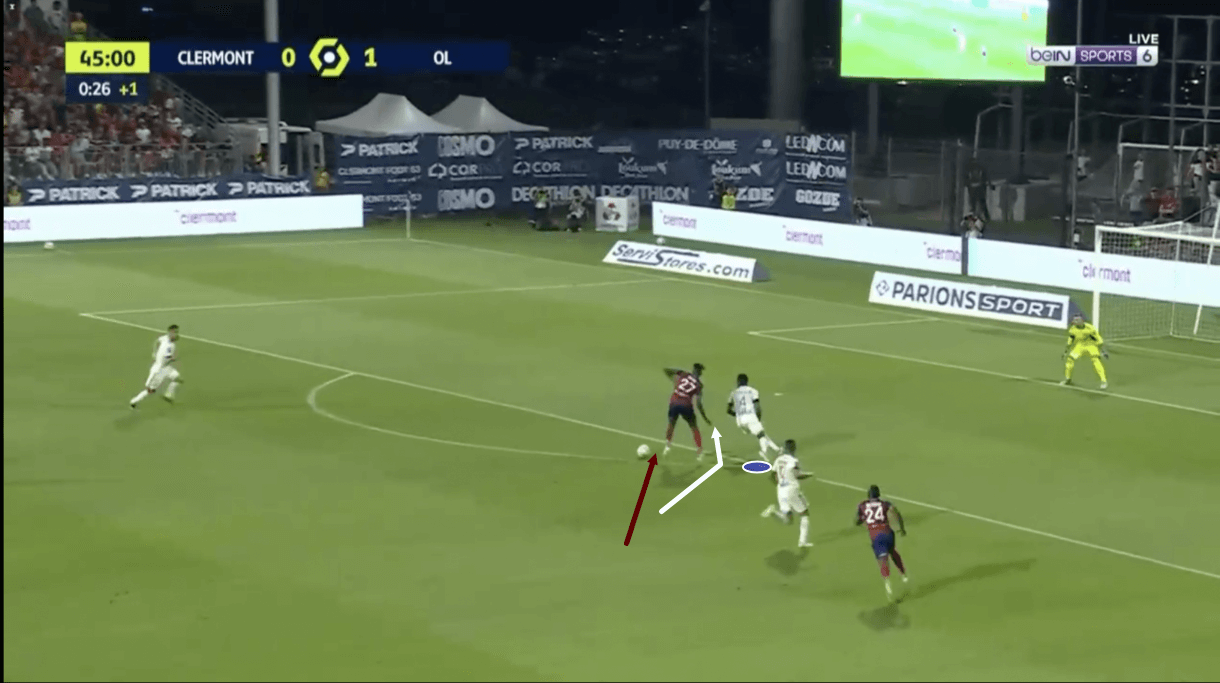
In our piece focusing on Lyon’s defence from earlier this season, we touched on the fact that Lyon’s primary central defensive partnership at the time (Boateng and Denayer) had a pretty poor defensive duel success rate, as well as a low number of defensive duels contested. This poor success rate likely came as a result of the two players often being put in defensive situations that didn’t best suit them.
Lukeba, however, ended the campaign with a very high 73.08% defensive duel success rate, which dwarfs the vast majority of Ligue 1 centre-backs’ respective defensive duel success rates. Again, one could attribute this to Lukeba’s suitability for the kind of defensive situations Bosz’s overall defensive system put him in. At the end of the day, the goal is always to combine system with the players at your disposal to create the best possible version of the team and under Bosz, Lukeba is very much in that best possible starting XI.
While figures 1-3 showed us Lukeba stepping out and defending aggressively, figures 4-6 show an example of Lukeba’s 1v1 defensive ability, though not in a wide area where 1v1 duels often occur, rather this 1v1 duel took place in a far more dangerous central area. Just before figure 4, the opposition sent a long ball forward and over Lukeba, into the attacker’s running path, as the attacker took his first touch, he got around Lukeba and into a very exciting position for his team, as we can see. However, Lukeba again showed great maturity in his game by remaining calm and reacting excellently to the dangerous developing situation.
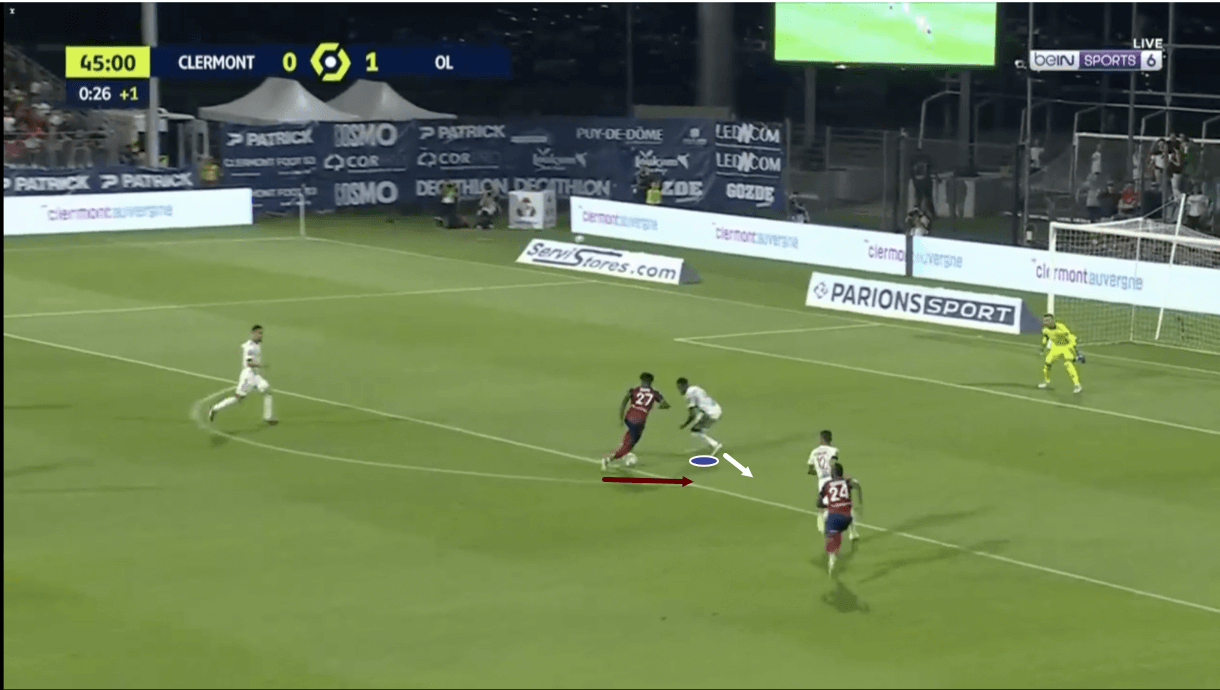
As the attacker drove past him, he showcased his impressive reaction speed, physical pace and agility to put himself just enough in front of the attacker again that he blocked the initial shooting opportunity here without having to commit 100% and completely selling himself. We see from figure 5 how Lukeba was able to get back in front of the attacker and get into a fairly stable body position. The centre-back’s body positioning here is great because he’s able to lower his centre of gravity while covering a lot of the area the attacker could potentially shoot at. Lukeba’s low hips here are crucial as we move on into figure 6 and see how the defender again reacts very well as the opposition striker pulls the ball across his body and back onto his right foot to try and wrong-foot Lukeba and create some space to get a shot off once more.
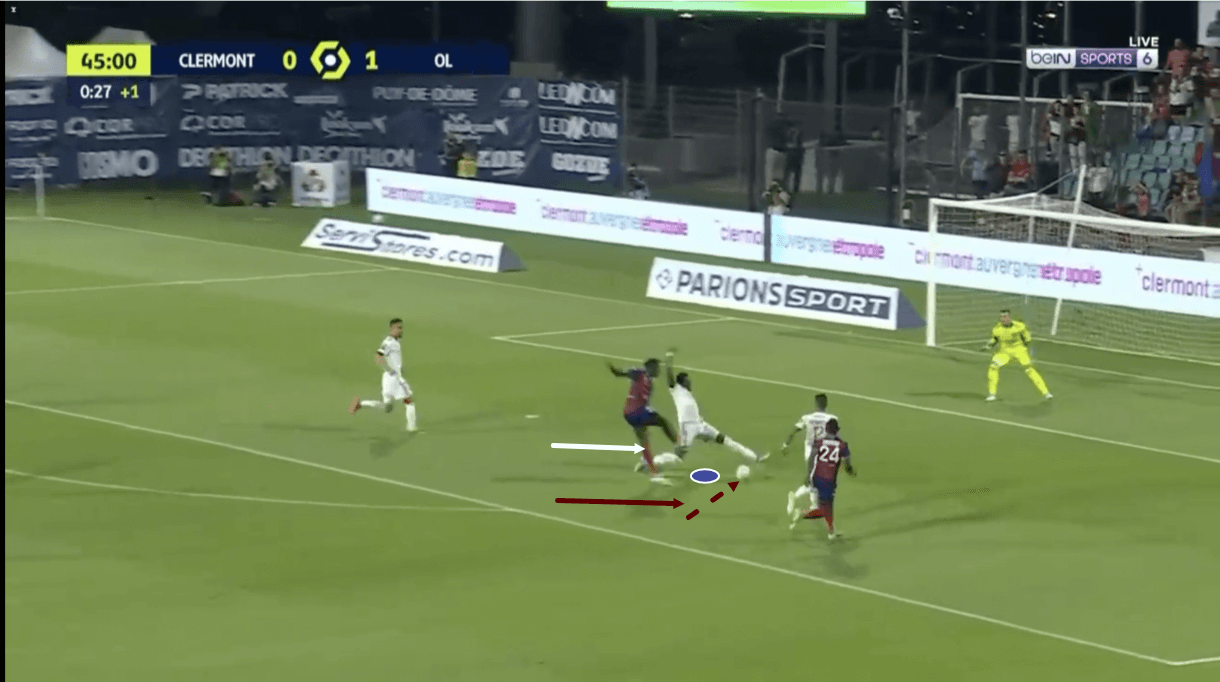
As figure 6 shows, Lukeba again managed to swivel his hips around, with plenty of the thanks for that going to his low hips and body positioning in the previous image, and remain in a good position in front of the attacker and the area he could potentially shoot at. When the forward takes his shot, Lukeba is there to pull off a well-timed block, getting his foot well behind the ball and knocking the ball well out of harm’s way, kickstarting an opportunity for his side to counter-attack.
This passage of play highlights a lot of what’s great about Lukeba in 1v1 defensive situations. He doesn’t rush into things and doesn’t sell himself too easily, rather he remains calm and trusts in his physical and technical ability to control the situation and prevent the attack from developing to a critical stage. When the time comes to act more aggressively, Lukeba’s prior actions ensure he’s in the best position to be safely aggressive and successfully end the opposition’s attack, despite the high level of danger associated with an attack like this one. This was some great defending from the teenager — something we witnessed a lot during his lengthy stint in the first XI in the second half of the season.
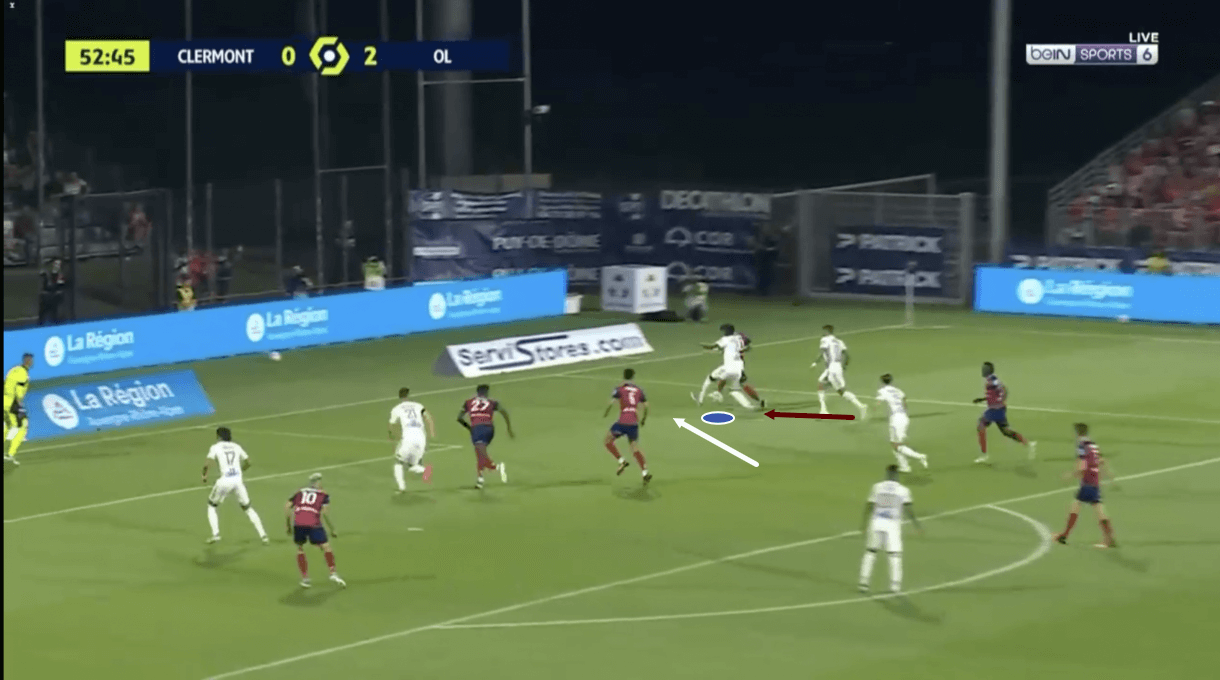
Lukeba similarly tends to act with calmness and composure when called out of the centre to a slightly wider position too. Here in figure 7, the opposition attacker has been played in past Lyon’s full-back but Lukeba responds swiftly, putting himself in a great position between the ball carrier and the potential crossing targets, while continuing to show his tendency to not jump in too early, instead just standing the attacker up, putting him under pressure, forcing him into a heavy touch and shepherding him towards the byline, out of play.
Lukeba is excellent at successfully applying pressure, with the centre-back ranking in the 85th percentile for successful pressure percentage when compared with centre-backs from Europe’s top-five leagues over the last calendar year, per Statsbomb via FBRef.
All in all, Lukeba has shown himself to be a calm and composed defender with great technical defensive qualities. He’s comfortable defending aggressively, in 1v1s and in recovering in difficult situations thanks to the attributes we’ve discussed at length in this section of analysis.
On the ball qualities
While Lukeba’s technical defending qualities arguably helped him to be an excellent fit for Lyon’s system under Bosz most of all this past season, his on the ball qualities also make him an excellent fit for the type of football that the Dutchman wants to see his side play, and this is an area in which Lukeba arguably excels more than in any other area. He’s a good defender with some weaknesses, including size and strength. However, on the ball, he’s a very good asset for starting attacks from the back, playing out under pressure and playing the ball into highly valuable areas with ease and composure.
The Lyon man made a relatively high number of passes (64.62 per 90), with a relatively high success rate (91.17%) when compared with other Ligue 1 centre-backs last season. However, he also made a very high number of forward passes (25.14 per 90) with a fairly high (81.96%) forward pass success rate and, lastly, a high number of progressive passes — a forward pass that attempts to advance a team significantly closer to the opponent’s goal — with 8.91 of those to his name per 90, though with an average 68.18% progressive pass success rate.
From this, we can see that Lukeba is heavily involved in his team’s possession play and we can see that the centre-back likes to drive his team forward. From watching the centre-back, we can also confirm this and say it’s clear why he’s so commonly used to drive his team forward from deep, as he’s a really nice passer of the ball with elegance, confidence and, as always for Lukeba, a great deal of composure present in this area of his game too.
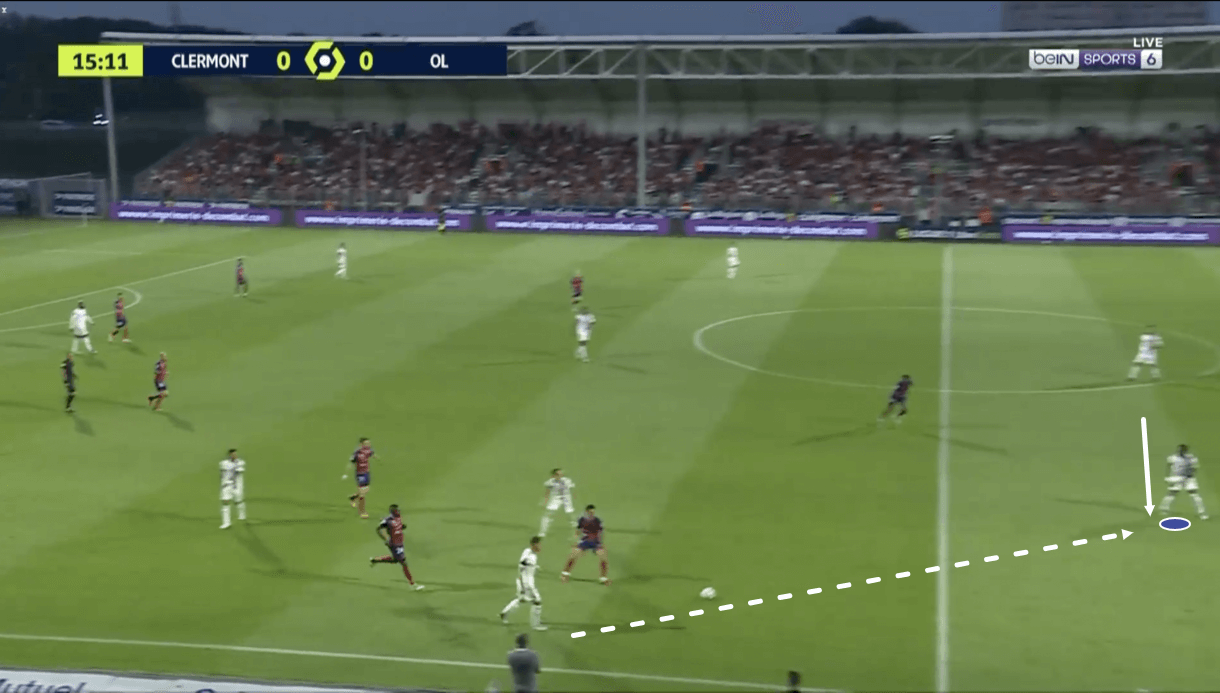
One of the most impressive things about Lukeba’s game on the ball is his ability to disguise his progressive passes via his body shape and positioning. This is a highly valuable skill as it makes his passing more unpredictable, thus giving the opposition less time to prepare and react to his next move. We see a couple of examples of this part of the young Frenchman’s game in figures 8-10. Firstly, in figure 8, we see how Lukeba has shifted out into a slightly wider position to give the under-pressure man on the ball a safe backwards passing option, which the ball carrier takes. This sees Lukeba receive the ball in the fairly wide position we see him occupying in the image above.
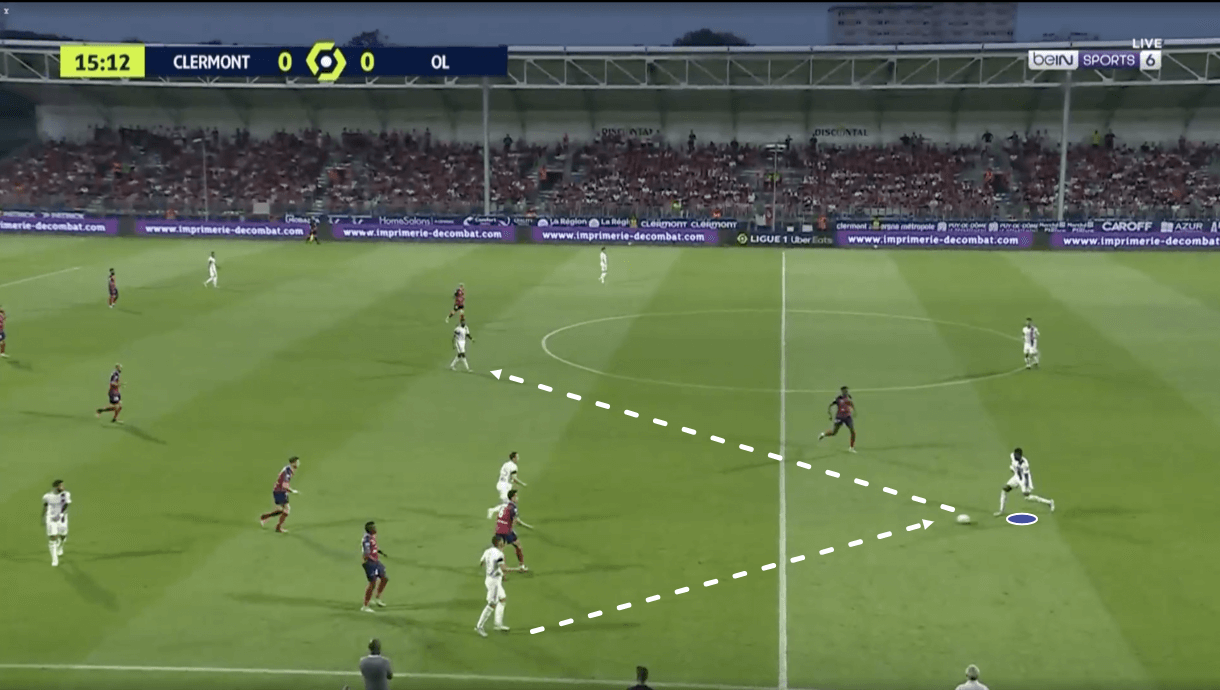
As play moves on into figure 9, we can see that Lukeba received the pass easily while still facing toward the player who passed it to him. It took until the moment we see in figure 9 when Lukeba pulled his left foot back to get any glimpse of his intent to slide the ball sideways into the central midfielder occupying a far more advantageous position than he or his teammate on the wing. Lukeba’s ability to disguise this pass until the last possible moment helped the intended receiver to remain free for longer and helped keep the passing lane open without telegraphing where the ball was going to go.
The centre-back’s technique on the ball helps him to pull off this move that his mind cooked up, as the ball slides gracefully into the intended receiver’s feet, putting Lyon in a much better position than they were in prior to Lukeba receiving the ball. The 19-year-old is excellent at adding threat to his side’s attacking play through moves like this that we’ve seen him pull off regularly this season.
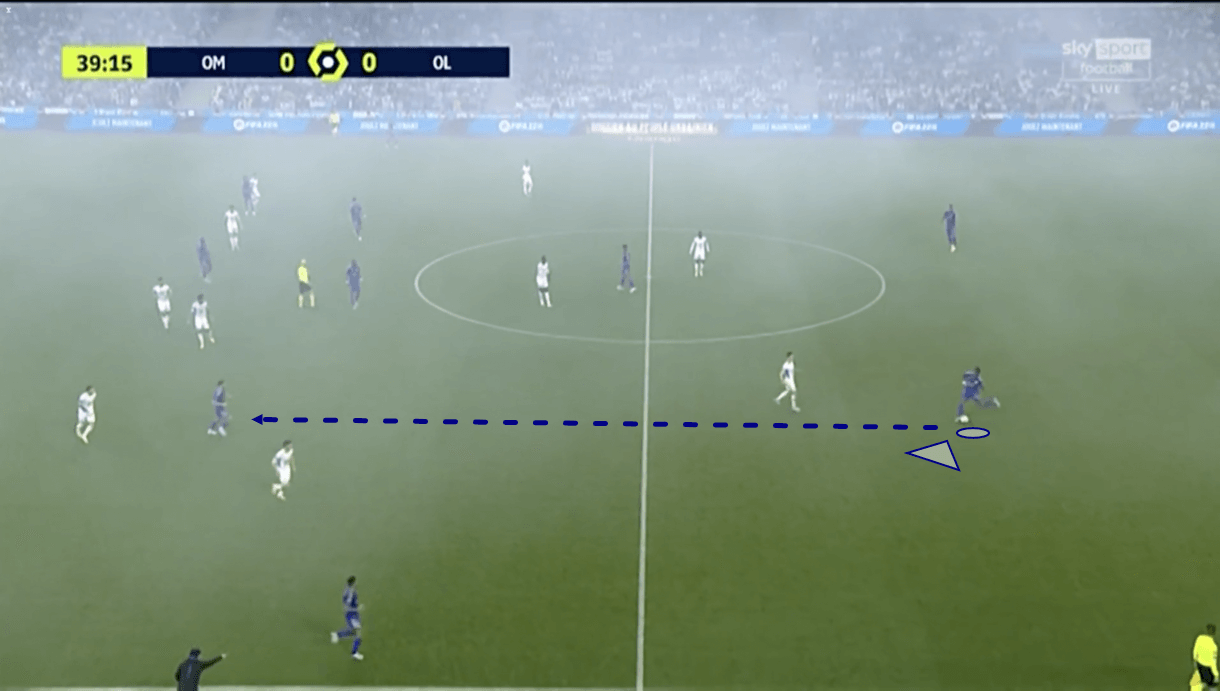
We see another example of Lukeba influencing the opposition to not cover his actual intended receiver by disguising his upcoming pass in figure 10. Here, Lukeba again continued facing towards the free man on the wing, this time with a view to pulling the opposition winger near his actual intended receiver — in the left half-space — away to the wide man. We can see this in motion in figure 10 and as the opposition winger began moving wide to cover Lukeba’s wide passing option, Lukeba, again, shows his hand at the last possible moment as he pulls his foot back at a seemingly awkward angle, driving the ball sideways into the feet of his teammate in the left half-space. This player then receives the ball well and turns to the inside to continue this attacking move.
Again, this passage of play shows us how Lukeba is a master at manipulating the positioning of opposition players, keeping his intended receivers open and as free as possible, and actually executing his ideas very well through impressive technique. Altogether, this makes for a pretty exciting centre-back on the ball.
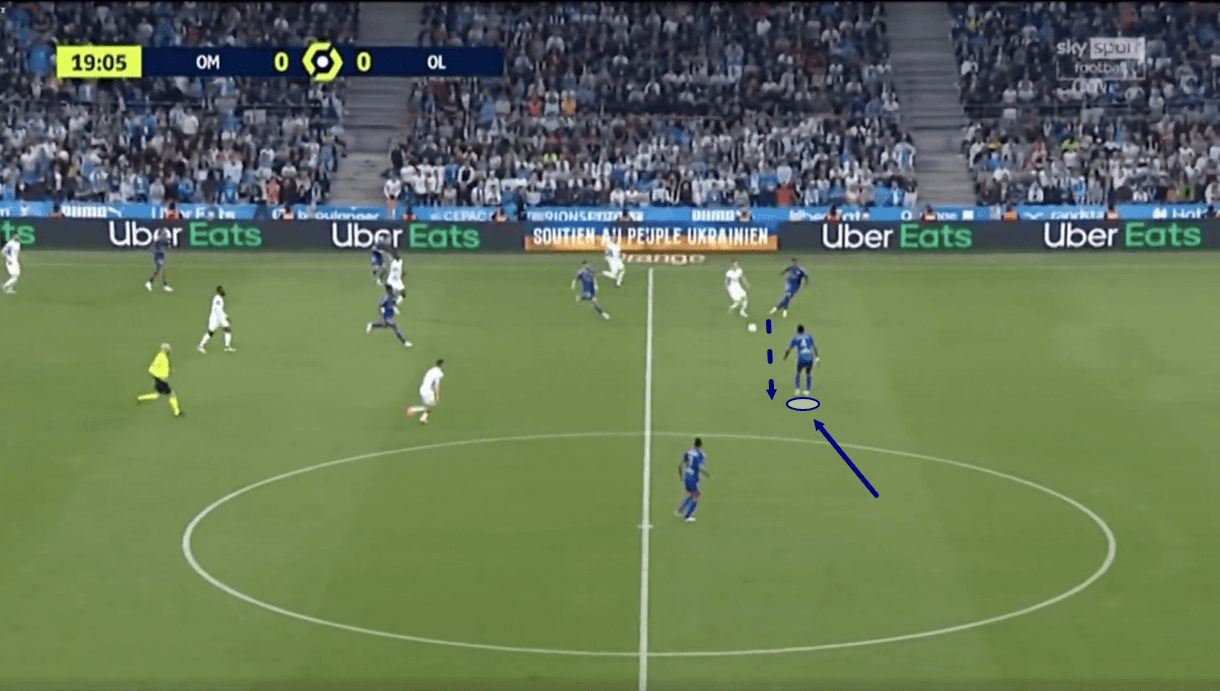
Figures 11-13 show us one more example of Lukeba’s progressive passing ability. This time, the centre-back shows off his impressive ability under pressure, as he receives the ball in the ball progression phase, with Marseille utilising a fairly aggressive press in the mid-block here. However, Lukeba is cool as a cucumber and after receiving the ball, having previously scanned at an appropriate time to make himself aware of the pressure as well as create a better picture of the pitch ahead of him in his mind, carries it beyond the opposition’s first line of pressure and into a more dangerous passing position.
We see him receiving the ball in figure 11 before then taking it away from the pressing player — who anticipated Lukeba would turn out onto his left foot — intelligently via his first touch, again, with plenty of thanks going to his scanning before receiving here.
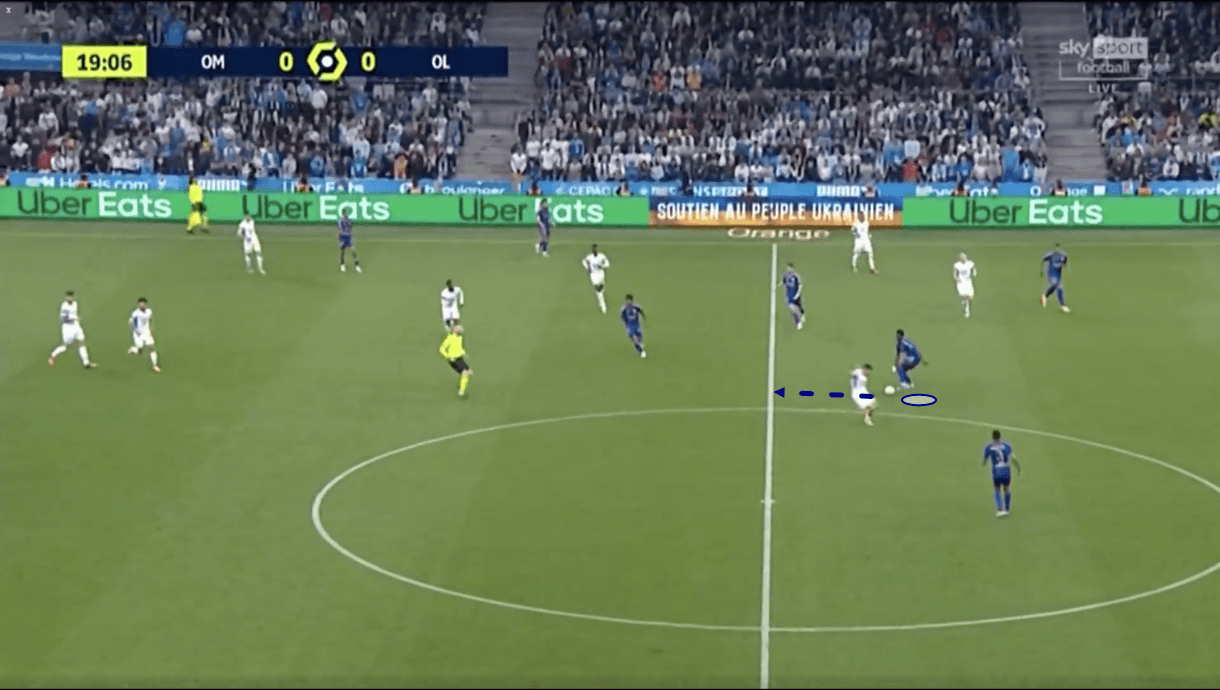
After evading the pressure with his first touch in figure 12, the centre-back buys himself a little bit more time so gets his head up, again surveying the pitch ahead of him, before making his next move to carry past the opposition’s first line of pressure and into a valuable, threatening passing position.
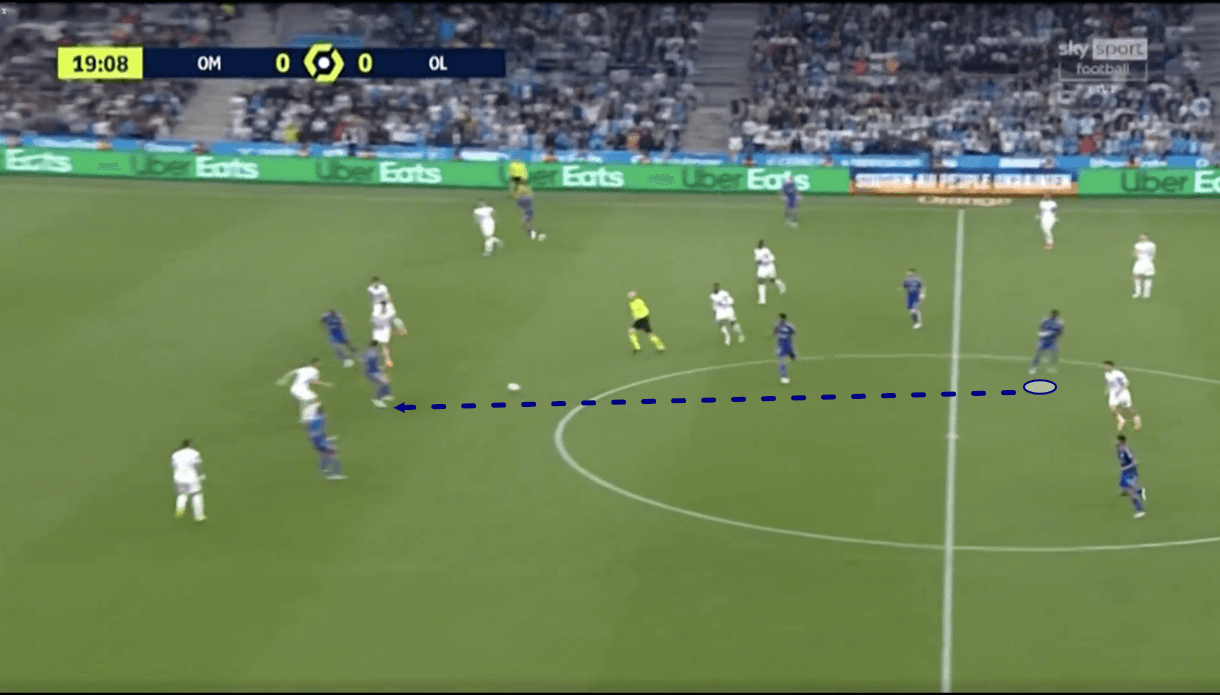
After settling down, getting his head up to check for the options ahead of him and making a decision, Lukeba exhibits some solid decision making and excellent execution of his next move by driving the ball into the feet of a teammate occupying the number ‘10’ position just in front of the opposition’s backline. This put Lyon in one of the most valuable positions they could’ve entered from where Lukeba just had the ball, thanks to the centre-back’s vision, composure, technical quality and bravery to actually try and execute a risky pass through the centre of the opposition into a very dangerous but very valuable position like the one we’ve seen them enter. Bravery is a clear part of Lukeba’s game from these examples that help him to be such a great asset for his side in the build-up and ball progression — and, ultimately, chance creation, as the player’s ability to drive his team forward into positions like this sets them up well for going on to break down the opposition in the final third afterwards.
One weakness in Lukeba’s passing game is his long passing. He struggles with decision-making and accuracy on his long balls, meaning that on the occasions he does choose to play them, they often fail to achieve much positive results for his side. However, Lukeba does tend to avoid playing them so while this means that, at present, he’s not the type of centre-back who’ll spread the ball all around the pitch for his team or launch the ball over the backline with great success, at least he and his team can hide the weakness by allowing him to focus on other areas of his game where he’s far better.
Per Statsbomb via FBRef, Lukeba ranks in the 90th percentile among centre-backs from Europe’s top-five leagues over the last calendar year for progressive passing distance and the 95th percentile for ground passes played, while he ranks in just the 8th percentile for high passes played. This is somewhat indicative of the kind of passer he is; Lukeba’s very much a frequent and effective ball progressor but he achieves this via ground passes, such as the types we’ve analysed in this section, rather than via long balls, which he very rarely plays — and probably for the best, at present.
Aerial ability
Lukeba has engaged in a fairly high 3.85 aerial duels per 90 this term and managed a fairly average (when compared with Ligue 1 centre-backs) 57.89% success rate with those this season. However, per Statsbomb via FBRef, the centre-back ranks in the 35th percentile for aerials won and 22nd percentile for percentage of aerials won.
Although Wyscout’s stats appear more complimentary of Lukeba than Statsbomb’s do, neither of them paint him as an aerial assassin of any kind and from watching the defender play, we would class aerial duels as a potential weakness in his game and certainly an area in which he can make strides moving forward. Lukeba’s physicality (strength, size and jumping height) is probably the biggest area the lets him down in terms of aerial duels but sometimes it would appear as though his anticipation of the ball isn’t great either.
We’ll look at Lukeba’s aerial game in this section and compare him with a centre-back of a similar height who fares far better in the aerial department — PSG centre-back Presnel Kimpembe.
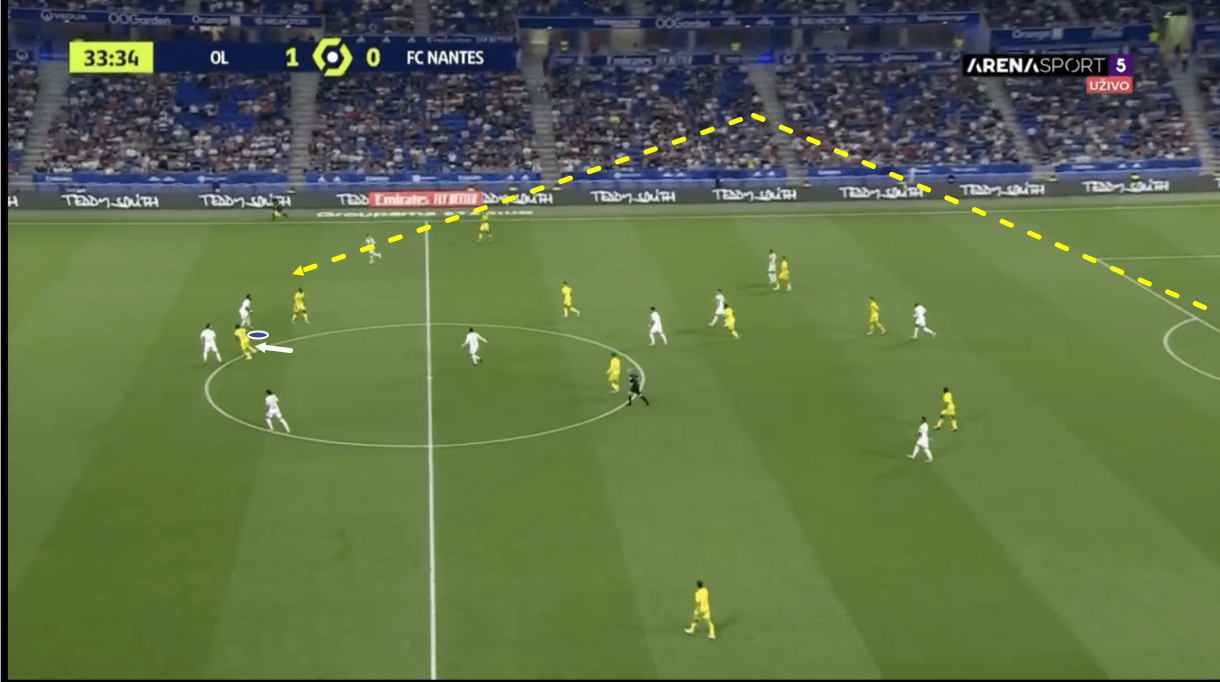
Firstly, as for Lukeba’s aerial game, it’s common to see the defender somewhat targeted with opposition target men sitting on him for goal-kicks and long balls from the back, such as the one we see in figure 14. It’s understandable why teams might choose to do this right now as Lukeba isn’t amazing at competing physically and can get fairly easily outmuscled and/or outjumped. In figure 14, though, it was more a case of Lukeba judging the flight of the ball poorly and standing much too far back away from the attacker and away from the drop zone. Just before this image, we saw the centre-back hesitantly take a couple of steps back while watching the ball and trying to judge its trajectory.
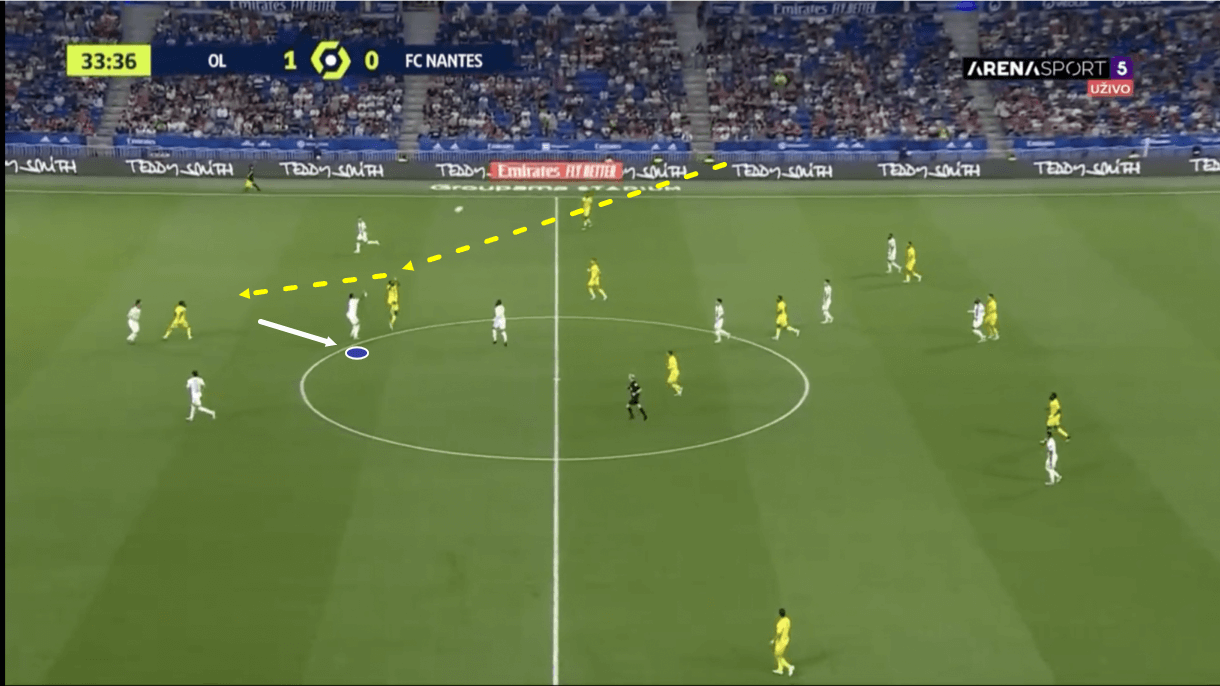
Progressing into figure 15, we can see that as the ball actually begins to drop, Lukeba jumps much later than the attacker. In the image above, we see that the attacker is already rising to his peak jump height while Lukeba is just bending his knees. In the end, the attacker easily wins the aerial duel, rising to the ball far quicker than Lukeba and managing to knock it on for the striker behind him to chase down.
In this example, we see how Lukeba misjudged the flight of the ball and timed his jump poorly when entering the aerial duel, leading to the ball dropping to the opposition attackers. This wasn’t a one-off example, rather these have been things we’ve seen a few times from Lukeba’s aerial duels this term. He does tend to enter duels late, sometimes as a result of poor positioning, and jump late, leading to the attacker rising far quicker than him and having a pretty much uncontested aerial duel.
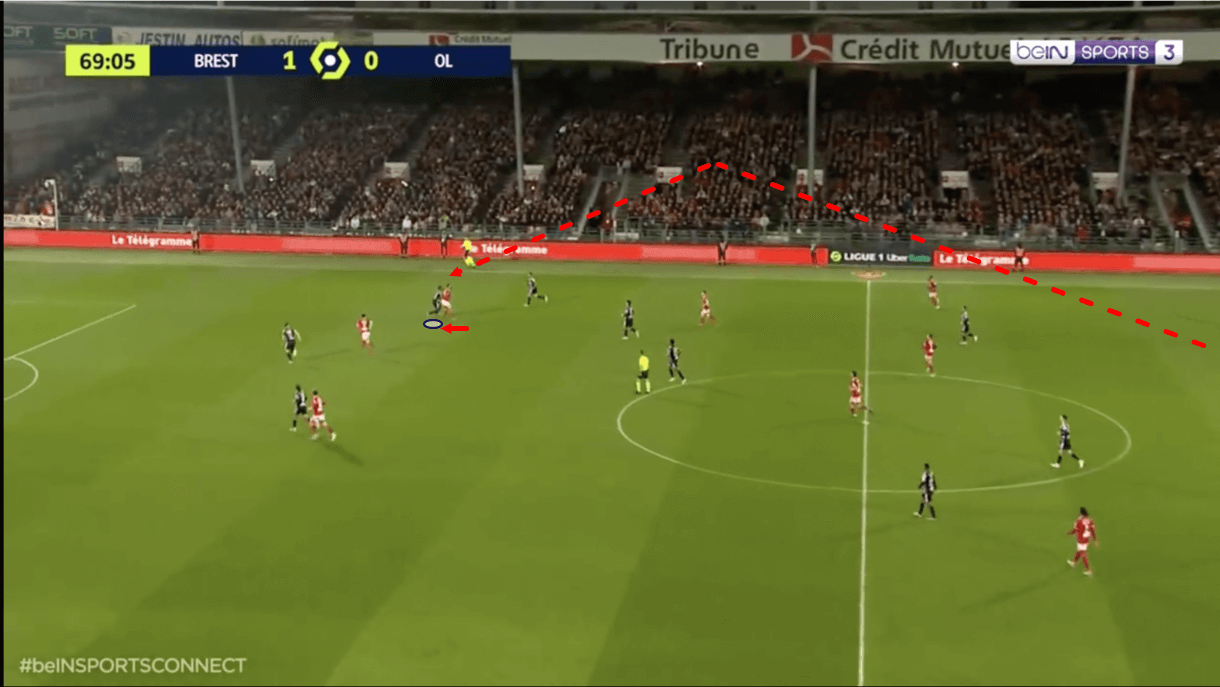
In figure 16, the problem clearly isn’t that Lukeba’s too far back, this time, he’s right behind the attacker. However, rather than bullying the attacker, aggressively controlling his movement, preventing his jump and increasing his chances of winning the impending aerial duel, it’s the larger attacker who’s in charge here as he backs into Lukeba, essentially bullying the centre-back and slowly pushing further into the position he wants to occupy as the ball drops for him.
Again, this isn’t a one-off, unfortunately for the teenager. We’ve seen larger Ligue 1 attackers really test him physically in his debut top-flight term and it’s clear, as one might expect when dealing with a teenager, that he has a lot of physical improvement to still do before excelling in this area in a league as physical as the French top-flight in the same way he excels in other areas as mentioned in prior sections of this analysis.
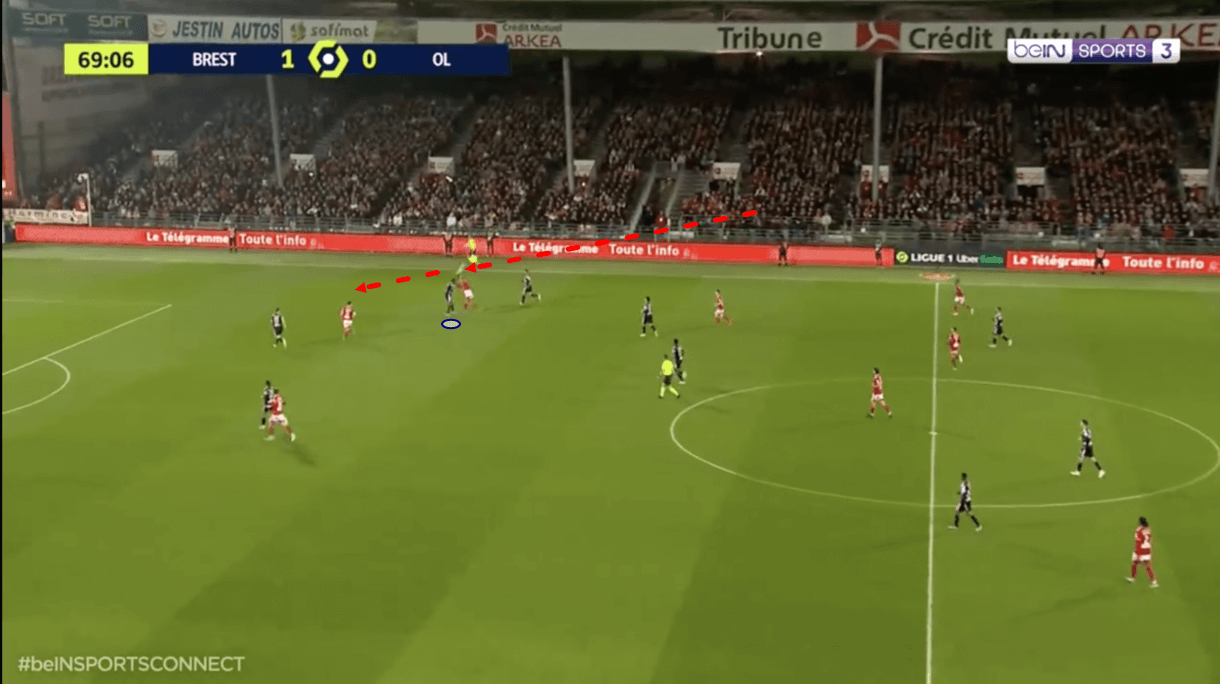
Again, thanks to his physical work on Lukeba, the attacker created an advantage for himself in the aerial duel, stifling the defender’s jump and creating an opportunity to rise above him and knock the ball on for an attacking runner behind to chase down and drive towards goal. We see this successful aerial duel for the attacker (unsuccessful for Lukeba) in figure 17.
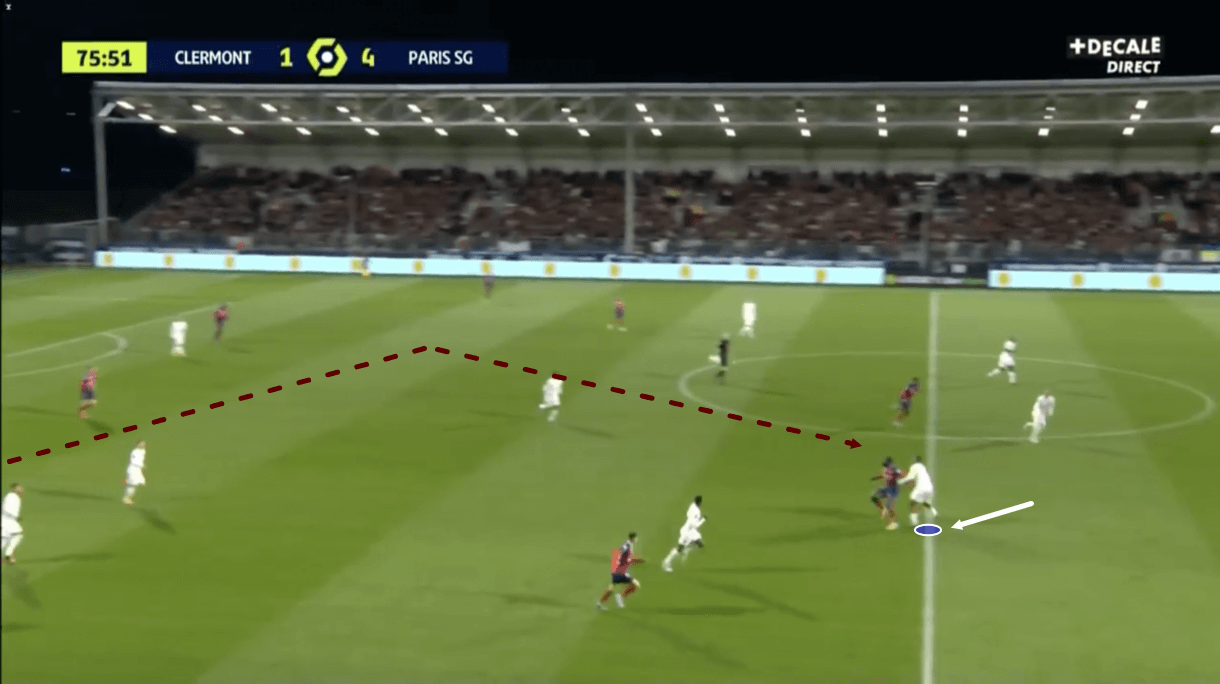
Lastly, let’s look at a defender of similar height (Kimpembe) to look at some things he does aerially (very well) which Lukeba doesn’t do enough at present to see how the young Lyon academy product can learn from PSG’s 26-year-old stalwart. Firstly, in figure 18, we see how Kimpembe steps up quickly to get tight to the attacker and engage in the aerial duel quickly. This doesn’t just prevent the possibility of the attacker having too much space and the defender having too much ground to cover when the ball drops, which we saw with Lukeba back in figures 14-15, it also allows Kimpembe to get physical with the attacker, pushing and pulling them to offset their balance and stifle their jump, ultimately helping to improve his chances of winning the impending aerial duel.
We rarely see Lukeba get physical like this when it comes to aerial duels, as mentioned earlier, though he enters ground duels aggressively and early, he’s not an extremely physical defender and doesn’t dive into challenges too quickly — which is a good thing — but when it comes to aerial duels, he can be a bit too passive at times. He must develop his physicality and aggressiveness to help him in this area, which will become more and more important as he progresses through the football world. At the moment, Lukeba is very promising and he has time to learn and improve but these are areas he needs to be actively improving now he’s at first-team level in one of Europe’s top-five leagues.
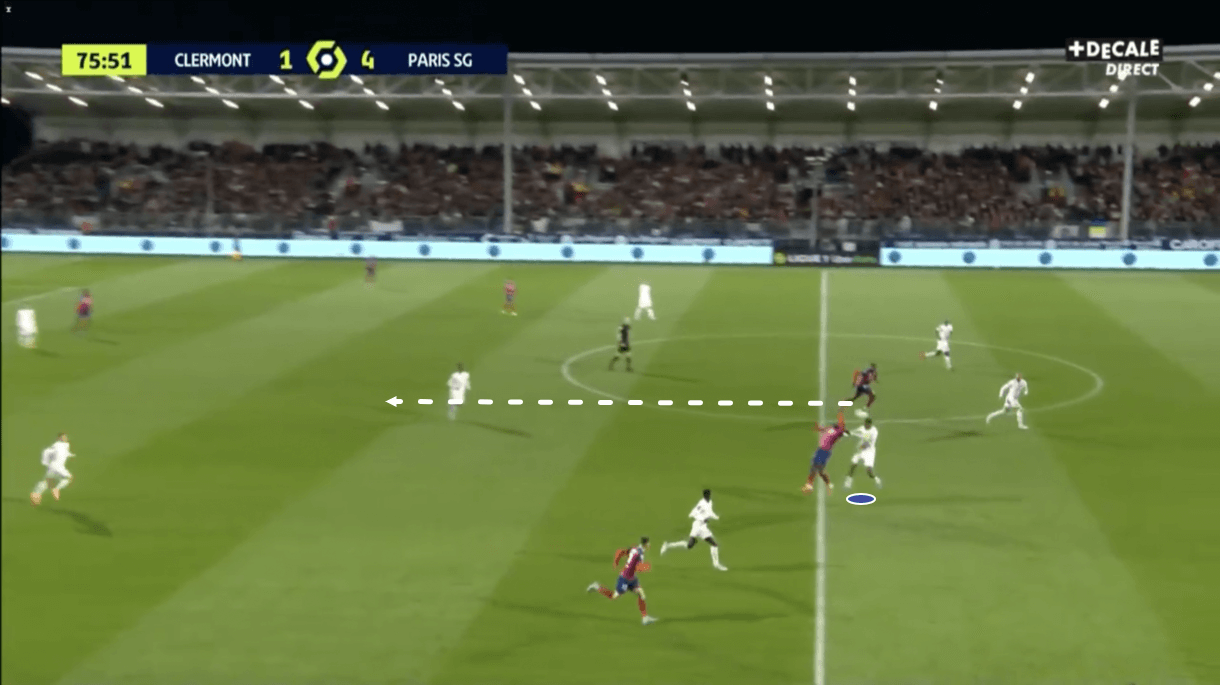
As this passage of play moves on into figure 19, we see that Kimpembe rose above the opposition attacker, whose jump was seriously stifled by the defender’s prior physicality and efforts to unbalance him, which clearly worked. From here, Kimpembe was able to knock the ball down into midfield, back into his team’s possession. Lukeba would do well to study some of what Kimpembe does so well in aerial duels — not necessarily to become him or try to become him — but perhaps to pick up one or two things he could add or improve in his own game to at least close the gap between the two centre-backs in terms of aerial ability.
Conclusion
To conclude this tactical analysis piece, Lukeba is a highly promising player at just 19 years old, with excellent technical ability both on and off the ball. He’s a calm and composed defender with solid pace and agility to boot, while his calmness and composure carry over to his game on the ball, as he’s demonstrated excellent ability to progress his team into highly valuable positions with great regularity — with disguised passing a particularly notable and valuable area of his game.
Lukeba can improve aerially and all-around in terms of physicality, with strength, size and jumping height standing out as particularly weak areas of his game right now. However, it must be stressed that this isn’t at all unusual for a 19-year-old and there’s still plenty of time to grow, though he must do that now to really round himself out. It’s not that he won’t make it at the top level without this, as he’s already stood out immensely at Ligue 1 level but he can improve a lot in these areas and if he does, the sky’s the limit for him.





Comments